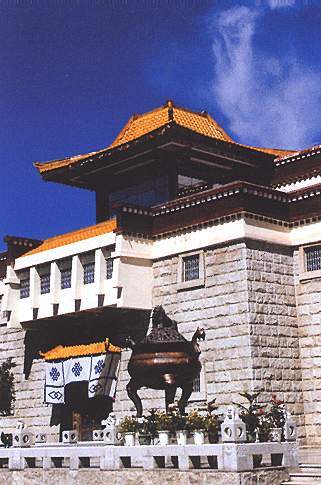Source:
04-30-2008 19:26
The Tibet Museum is located at the southeast corner of the Norbulingka Road in Lhasa. It is the first large-sized comprehensive modern museum in the Tibet Autonomous Region; it is a brilliant literary and arts palace of the Tibetan people, a gem of Tibetan civilization and a treasure house of Tibetan cultural relics.
 |
| A corner of Museum |
Funded by the central Government, the Tibet Museum was built under the kindly care of the Central Committee of the Communist Party of China and the direct leadership of the Party Committee and People's Government of the Tibet Autonomous Region. General Secretary Jiang Zemin inscribed name for the Museum. It was open to the public on October 5,1999. The site of the museum covers an area of 53,959 square meters, with a total construction area of 23,508 square meters. The area for exhibition department covers 10,451 square meters, consisting of three sections: a main exhibition hall, a folk cultural garden and an administrative quarter. The building is magnificent, and combined Tibetan traditional architecture with modern technology. Its characteristics are unique. Together with its neighboring Norbulingka Park, it has become one of the most beautiful places in the ancient city of Lhasa.
Before the Tibet Museum was built, numerous cultural relics in the Autonomous Region were kept in shabby storehouses of the departments in charge of historical relics, others were scattered among and kept by the common people. Because of the limitations of exhibition, those relics were seldom put on display for the public, and there were fewer opportunities to introduce them through publication. As a matter of fact, the rich cultural connotations of these historical relics were not utilized. At the present, under the new conditions of reform and opening up to the outside world, to build in Tibet a large-scale museum with rich content is to inherit and develop our predecessors' career. It has become a center for the broad masses of people to understand the Tibetan history and culture. It has also become a new place of interest in Lhasa, the capital city of the Autonomous Region.
The Tibet Museum has a rich collection of cultural relics, including various types of cultural relics of prehistoric period, title-conferring documents issued by the feudal dynasties of past ages, seals of authority, gold albums, gifts granted by emperors. There are also numerous statues of buddhas, bodhisattvas, and figures. There are also rare sutras written on pattra leaves and birch bars, and manuscripts written with gold powder, silver powder, and coral powder. There are also various printed Sanskrit and Tibetan scriptures and colorful tangkas of various painting genres. Unique Tibetan handicrafts, costumes, jewelry, gold ware, silver ware and jade ware are also in the collection. All these are of excellent quality and are invaluable.
